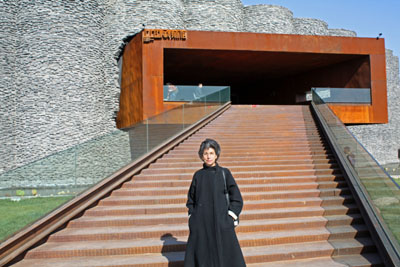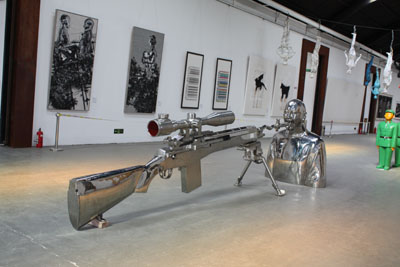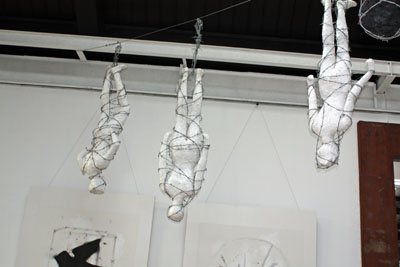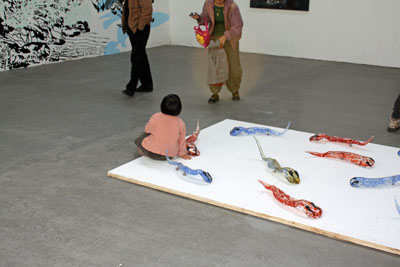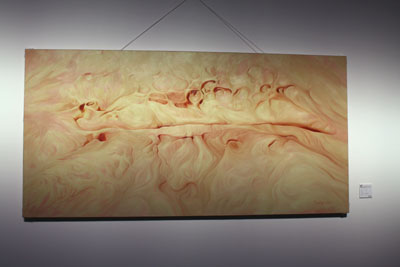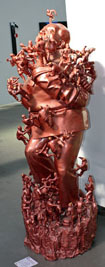
| ARTWORKS | STATEMENT | WRITINGS | EXHIBITIONS | CONTACT |
China Diary #10 |
We went to lunch at another local restaurant, which featured lamb. Everything was excellent. This restaurant was also built into the side of a mountain. We started with a beef soup that was delicious. Sun Yuan, the boss’ daughter explained that starting with soup after some small appetizers was a new way of eating in China. But the last main course was still another hot soup. At approximately 2:00, Paul, a high school English teacher, came by with Yuan’s sister-in-law to handle the negotiations for price and delivery. We were originally to meet at 3:00, so they agreed to let me work until then and watched. Paul told me that he had never been to an art museum before as there were none in the area. I thought this was strange since a number of individual artists had their own personal museums in the area. Also, as the center for high quality ceramics and glass in China, you would think that the local businesses would support a ceramics and glass museum. Price negotiations were fairly straight forward. The difficult part was the delivery since in translation there was lots of confusion. I wanted delivery directly to my studio and was willing to pay more for door-to-door delivery. Last time this is what I thought I had arranged for. But the goods were delivered to somewhere in Central Beijing and Professor Wang had to make the arrangements and spend the time to get the goods to my studio. Once I understood that everyone was trying to be helpful and concerned it made working out the details a lot easier. But, it still took 3 hours between Yuan, her interpreter, Paul, Professor Wang, Sun Yuan’s sister-in-law and Snow Cao to work out who was responsible for what. We will see what happens.
Professor Wang had made arrangements with his friend Mr. Sun of the local government to have his driver pick me up at 8:20. I had met and had lunch with him on my prior trip to Boshan. His sister was with him. She spoke no English. On the way to the Zibo train station, we took a detour and picked up her blind mother to join us for the ride to the station. Because he is a high ranking government official, his car does not need to pay the toll on the new super toll road. I got to the station 3 hours before departure and it was almost empty. The driver made sure I was at the right place. By 11:30 the station became very crowded. I almost did not make the train because they opened up the gate 5 minutes before departure time and you have to climb up 4 flights of stairs and then down 4 flights to get to the train. Fortunately someone helped me with my heavier suitcase. Although I was told by Professor Wang that the trip back with would be seven hours, it looked like and felt like a high-speed train that I took to Zibo. In fact it was a high speed train and I had to scramble at the last second to get everything assembled to get off the train before it went to the yard. On the way home I got a telephone call from Helena. She and her sister wanted to join me for dinner so they could practice English and I can practice Chinese. We went to the local Chinese restaurant and the three of us had a delicious meal for less than $4. The temperature had dropped dramatically and it was bitterly cold. Tomorrow I will make sure that coal is delivered and the furnace is working. Going to sleep that night was an adventure as everything was extremely cold. Before I went to sleep I spoke to Leslie in her office. Day 8 I then went to a local restaurant for quiet lunch and to study some Chinese. I ordered hot and sour soup, some cold fungus and cabbage with chicken. The $.75 bowl of soup was enough to feed six people. So I ended up taking home some of the fungus and cabbage for tomorrow’s breakfast. After lunch Li Kogen came over and showed me that a simple adjustment would have solved the hot water problem in the upstairs bathroom. But we did have trouble with fixing the outdoor lighting fixtures. Lau Shan came by and we discussed with him that he should not screw on the outside lighting fixture covers too tightly. Also, coal was delivered so that there would be heat for tomorrow night when Leslie arrived. I was exhausted and took a nap. I had a business meeting in downtown Beijing. Getting there was an adventure. First, Huang forgot to pick up his wife. He then went to his brothers to switch cars. The brother is an even more erratic driver than Huang, going the wrong way on one-way streets as a shortcut. What should have been a very direct trip became an adventure. After we concluded our business, the Chinese wanted to discuss the upcoming election. Bing believed that the polls were not accurate because when push comes to shove many white Americans when they get into the polling booth will not vote for a black man, no matter how intelligent or capable. He also felt that McCain was a big improvement over President Bush but he was having a difficult time distancing himself from Bush. Bing had a meeting with a high government official and excused himself, but Martin, Fan and YuJie, three young attorneys on Bing’s team, joined me for dinner at a hot pot restaurant in the basement of their office building. Martin was raised and educated in Melbourne, Australia, and was fluent in English. Fan was very shy but eventually opened up and started to speak English. YuJie did not feel comfortable talking in English or listening to my beginning Chinese and focused on her cell phone. Martin is also an avid scuba diver. He especially likes diving for abalone off the coast of Australia. He had many questions about America. So did Fan. Eventually YuJie separated herself from the cell phone. The restaurant turned off the lights on us so we had no choice but to agree to meet again. The taxi drive home was uneventful. But I was able to have a conversation with the taxi driver in Chinese. After checking my messages on the Internet it was time to go to sleep.
Leslie was arriving that afternoon. So I decided to chill out at the studio. I sketched out some ideas on how to arrange the new glass sculptures. I wrote a follow-up e-mail to Ai Mei relating to the shipping of the sculptures, read about Tibet and studied some Chinese. It was a beautiful sunny day but, it was cold and windy. I decided to take a ride on the electric bicycle to explore the area north of 318 Art Park. It was then time to go to the airport. However, on entering the Airport Expressway we were stopped by the police. There was no traffic on the expressway which meant there was a major accident or some important dignitary was going to the airport. We got to the airport just in time. Although Leslie’s plane landed at 2:00 she was not able to get her baggage and clear customs until after 3:00. It was good to see her and she looked extremely fresh after a 13-hour plane ride and waiting over an hour for her baggage and to be processed through customs. Leslie and I then went to the Red Gate Gallery in 798 to see the opening of the show featuring artists from Tibet, including Gade. We spent a lot of time with Gade and with the help of the interpreter were able to have a good conversation. Unfortunately he was going to be in Beijing during the entire period that we were going to be in Tibet. But Leslie was able to get the phone number and name of the proper contact person in Lhasa so we could meet with local artists who were part of the artist’s collective, there being no galleries in Tibet. We then off to dinner to join John Brennan and Madeline O’Dea, along with some of their friends at a French restaurant in the Sun Lai Tung district. This district is a combination of bars, nightclubs, a red light district and some good restaurants. One of their friends, Bruce, was an archaeologist as well as an art consultant. His friend Ian was a former professor at a university who is now teaching at a private school in Tsingdao, a coastal city of approximately 4 million people, with another 4 million in the equivalent of what we would call the suburbs. Although the city had no culture, he really enjoyed the pace of life and friendliness of the people. He echoed Cao Snow’s comments about Tsingdao. Bruce then described to us the existence of interesting caves in western Shandong Province, and in particular the art on the walls in the caves in the Boshan area. Bruce also described that he and Ian had just been to the Sheng Sheng. Ian had lots of pictures of the museum and both he and Bruce thought the art at the museum was of extremely high quality. Bruce complained that too many other museums and certain well-known galleries showing bad work of well-known artists. We then had an interesting discussion of the upcoming American election. John felt that the polls could not be that inaccurate and that Obama should win. Also, everyone was concerned about the impact in China of the meltdown of the American stock market and economy. I was told that almost half the galleries in 798 had closed either because of declining sales or the anticipation thereof. We finally got home by 11:30. The house was nice and warm as the heat was working well, almost too well. Day 10 It was off to the Sheng Sheng, also known in English as the Sunshine Museum, with Huang as our driver. As usual he made it an exciting and nerve-racking drive. But, after a number of wrong turns, backups at intersections for missed turns and stops we finally found the museum. Leaving a half hour for Huang getting lost is a good idea, as we arrived at exactly 11:00 to meet Grace. Grace was not there, but Guo Li Hau, the director of the museum was there. The museum is extremely large and the opening with the rusted out frame to the entranceway is spectacular. Immediately after the entrance is a very large room which can accommodate very tall and large works, such as one of Peter Lewis’ 15 part paintings. The galleries all are of a long corridor used to display large sculptures
We met with Guo Li Hau, the Director of the museum at my sculpture installation. Contrary to what I was told by Abraham, the museum had a lot of visitors, mostly adults but sometimes accompanied by young children and there were a lot who visited and spent time looking at my sculpture installation. What I found especially interesting was that young children wanted to touch and feel the glass.
Peter had advised me that the base was put together at the last second because there was not enough wall space in the room where the installation was to be installed and that I may want to redo the base. I spoke to Grace and Li Hua about painting the exposed edges white and she said she could try do it. Although this installation was designed to hang on the wall or from the ceiling, it seemed to work on the floor and the viewers were drawn to it, especially children. If I had known that this was going to be a floor installation, I would have done the platform differently. But I was not there for the installation so I was grateful for what Peter and Lorenzo did in constructing a base when there was not enough wall space for my installation. We then went into the other galleries of contemporary art. There were lots of good pieces.
Grace, Guo Li Hau, Leslie and I then went off to lunch. Since the restaurant selected by them was a short distance away we took a mechanized rickshaw type vehicle. It did not go very fast but it got us there. The restaurant looked like an art gallery and had an art gallery name but inside it was clearly a restaurant that had paintings on the wall for sale. It was not fancy but it was modern, clean and well lit. The food was also very good and reasonable. Li Hau explained to us that most of the new museums in China are privately funded and the Sheng Sheng Museum is dependent on admissions fees to pay its ongoing expenses. Since the Sheng Sheng was a new museum it did not yet have the necessary capital to start an acquisition program. Grace was going to return to the university to become an international lawyer. She lived with her parents to save money for her schooling. She had been in the workforce for seven years and wanted to change from the art world to the legal world. There was an art fair across the street and Grace wanted to go to. We all decided to join her. However, near the restaurant was a frame store and I wanted to buy a special type of hanger hook for the new series of glass sculptures. So we stopped there first and eventually were able to locate the right kind of hanger hook. The work in the art fair was a slightly better quality than the work in the art tent next to be museum, with some interesting sculptures from Xiang Xi and one of the artists who did work that was reminiscent of Keith Herring. That work was also similar to an artist from Europe who was in the international room at the Sheng Sheng. It was time to return to the studio since were meeting Professor and Mrs. Wang for dinner. We invited them in for wine and started discussing Mr. Sun’s expressed concerns to the professor about the delivery arrangements. Two hours later we set up totally new arrangements. The sculptures were to be delivered by bus from the factory to the central bus depot in Beijing. Sun Xin a graduate of Tsing Hua University and Professor Wang’s designated chief technician at his new studio was to coordinate with the bus depot to make arrangements to deliver the sculptures to my studio. Wang Pei also gave us a book in Chinese to deliver to her daughter in New York City. Sun Xin recommended a new restaurant very near the studio, which had just opened. It was beautifully done and the food was excellent. I would definitely like to go back there. Sun Xin invited us for tea but we had to decline because we were leaving early the next day for Tibet and had not yet packed. It was already 9:30. Both of us completed most of our packing that night. |
|
|
|
Copyright 2008
Charles Hecht |
